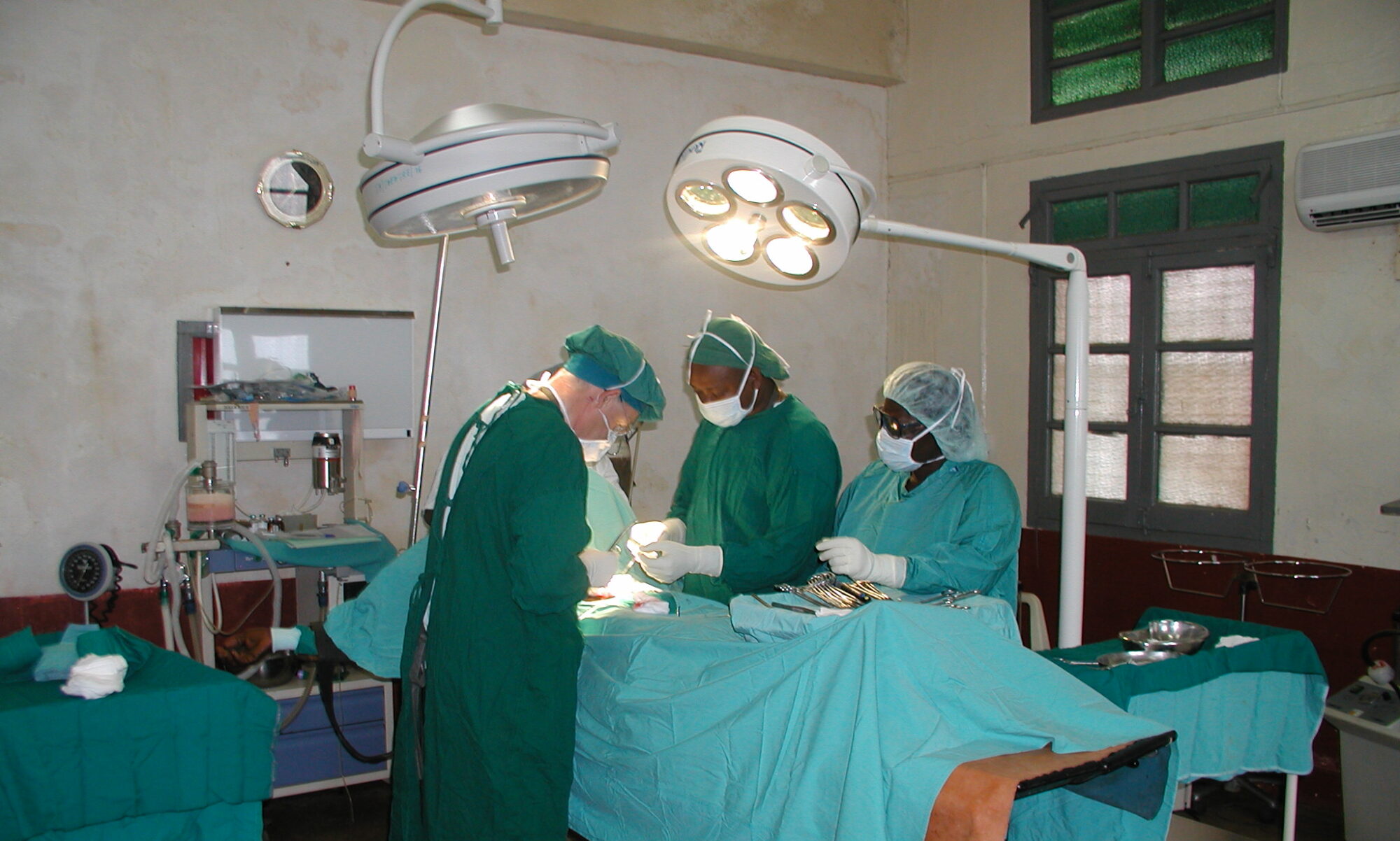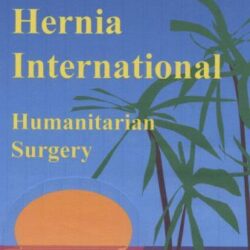THE TEAM
John Hobbiss. Surgeon
Fernando De Santiago Urquuijo. Surgeon
Steffen Rose. Surgeon
Paul Robinson. Surgeon
Jenny Hobbiss. Surgical Trainee
Insiya Susnerwala. Anaesthetist
Danni Volling-Geoghegan. Anaesthetist
Claire Nuttall. Operating Department Practitioner
Jaime Owen. Operating Department Practitioner

THE HOST
The Anglican Church Diocese of Tanga,
St. Augustine Muheza Designated District Hospital,
P. O. Box 308,
Muheza,
Tanga Region,
Tanzania.
E-mail: [email protected]
Host Surgeon. Dr Michael Boniface
This was the first Hernia International team to visited Muheza. Dr Michael Boniface, a surgeon working at St. Augustine Hospital, had joined the Hernia International mission to Korogwe in June 2023, where his contribution had proved invaluable. It was at his request that this mission to Muheza was organised.
Muheza is described in Lonely Planet, as a “scrappy junction town” on the road to Tanga. We found it to be a lively market town with bustling stalls selling locally grown produce, including pineapples, bananas, rice and, we were surprised to see, potatoes. The abundant motor bikes made crossing the road from one market stall to another particularly hazardous.
Muheza is situated on the coastal plain, just south of the Usambara mountain range that stretches across northern Tanzania from near to the Indian Ocean coast in the east to Mount Kilimanjaro in the north-west. The hills are visible to the north of Muheza, but the surrounding countryside is relatively flat and not as scenic as the rolling hills around Korogwe, 60 km to the west.
CUSTOMS AND TRANSPORT
We were met at Dar Es Salaam airport by Dr Boniface, whose presence proved to be invaluable in enabling us to bring our equipment and medicines through customs. Fernando and Steffen came on a Turkish Airlines plane via Istanbul. Their four large cases, full of equipment and drugs, were not transferred onto their flight from Istanbul. They arrived in Dar Es Salaam the next day, by which time we were all in Muheza. Turkish Airlines agreed to fund a taxi to transport them to Muheza but persuading the airport customs department to allow them through proved to be more of a problem. It required a member of staff from St Augustine Hospital (a hospital pharmacist was “volunteered”) to travel from Muheza to Dar Es Salaam airport, a day’s journey by bus, with a letter from Steffen which explained the contents of the cases and authorised the customs personnel to open and inspect them. The Customs Officers must have accepted what they found, as all the bags and their contents arrived in Muheza on Thursday, our fourth working day. Their arrival was timely, as we had just about run out of the antibiotics and analgesics that the rest of us had brought.
On the night of our arrival at Dar Es Salaam, we stayed at an airport hotel (the Transit Hotel had functioning air conditioning and was perfectly satisfactory) and travelled to Muheza the next day in the St Augustine minibus, arranged by Dr Boniface. It was a six-hour journey on a tarmacked road, with a pleasant stop for lunch halfway there.
We arrived in the late afternoon, in time to organise our equipment in the operating theatres and to see the patients that Dr Boniface had arranged to come to the hospital for consideration for surgery the next day.

THE OPERATING THEATRES AND THEATRE STAFF
We had the use of two spacious, air-conditioned operating theatres. Both had a single but satisfactory overhead operating light. Power cuts were common, however, and although they were usually short lived, headlights were essential. There was only one diathermy machine, so that all the surgery in one of the theatres was done without the use of diathermy.
Both theatres had anaesthetic machines, and monitoring equipment (pulse oximetry and ECG trace). Bottled oxygen was available. None of our patients received a general anaesthetic. Nearly all patients had a spinal anaesthetic only. A few patients required supplementary boluses of ketamine. This was required when the procedure was unusually lengthy and in the one patient in whom both bupivacaine and lignocaine were ineffective. The one child, who underwent groin surgery, had local anaesthetic and ketamine.
We had specified that we planned to operate on hernia cases only and that we did not wish to operate on young children. We worked in the two theatres for the five days. We aimed to arrive at the hospital at 8 am each day and were asked by Dr Boniface to finish our day’s work by 6 pm. This was to allow the significant number of theatre staff, including the sterilising unit personnel, who were required to support our mission, to leave the hospital in reasonable time. The hospital provided a cooked lunch in theatre for all the theatre staff, including us. We were asked to contribute to the cost of this food, which we were very happy to do.
THE WORK
We operated on 51 patients, repairing 41 inguinal hernias, of which 31 were primary and 10 were recurrent. Nine were irreducible inguino-scrotal hernias (Kingsnorth grade 4). None of the recurrent hernias had had a previous mesh repair, but in many of them we encountered intense fibrosis. It was the recurrent hernias that provided us with the biggest surgical challenges of the week. There was one incarcerated inguinal hernia in a man who had presented urgently the previous day.

There were 4 umbilical hernias and three midline hernias. We were also asked to see a 47-year-old lady with a large discrete mass at the top end of a previous caesarean section wound, almost certainly an endometrioma. This was excised.
We operated on 13 hydroceles and undertook one ligation of a patent processus vaginalis on a 13-year-old boy.
PERIOPERATIVE MEDICATION
Our intention was that all patients who were to have a mesh repair, should have an oral dose of broad-spectrum antibiotic at least half an hour before their procedure and then a two-day course of antibiotics and oral analgesia (a paracetamol / ibuprofen combination) postoperatively. Each patient was given an envelope containing their post-operative medication as they left theatre. Instructions on how to take the medication was written on the envelope in English and Swahili. When we saw the post-operative patients on the morning ward round, we discussed their medication with them and examined the envelopes. It seemed that most of them were taking their medication appropriately.
ACCOMMODATION
We were initially told that we could stay in residential accommodation within the hospital complex. At the time of our visit, however, this accommodation was being prepared for visiting medical students. We were booked into The Sige Lodge, one of the few hotels in Muheza. It proved to be very satisfactory. There were enough rooms, all of which had air conditioning, although the intermittent power cuts meant that the air conditioning didn’t always work. As we arrived, a router was being installed to provide us with wi-fi, but that, at best, only provided a weak signal, which was usually inadequate. There was a pleasant open air dining room in which we were served omelettes for breakfast each morning. Dinner was provided by an external caterer. A lady, with whom, by the end of the week, we felt we were good friends, would arrive at the hotel each evening by tuktuk, bringing the food that she had cooked during the day with her. In spite of the wet and muddy dirt road to the hotel, she was always smartly dressed, spotlessly clean and greeted us with a smile. She took great pride in her cooking and with her food and the bottles of Kilimanjaro beer provided by the hotel, we had no complaints.
EXPENSES
By far the largest individual expense for future missions to Tanzania is likely to be the cost of temporary registration with the Medical Council of Tanganika. The Council have changed their policy on this and now charge medical staff on short term charity work the same as those doctors and nurses applying to do full time work. For us this was $200 per application.
Otherwise, Tanzania is not an expensive country. The minibus transfer from Dar Es Salaam to Muheza was $500, in our case split between the nine of us on the way there and seven on the way back. Dinner, bed and breakfast cost $30 a night. The Sige Lodge required payment in cash (US dollars). The Dar Es Salaam hotels accepted credit card payment.
REST AND RELAXATION
One of the bonuses of a mission in Tanzania is the variety of leisure activities that can provide relaxation afterwards. Two of our team travelled to Arusha at the end of the week and went on safari in the Ngorongoro Crater before flying back from Kilimanjaro International Airport. Three of the team travelled back to Dar Es Salaam and then took the ferry to Zanzibar for a short holiday there. Some of us were content to have one very comfortable night at The Slipway Hotel in Dar Es Salaam before flying home the next day.
CONCLUSION
We all agreed that we had a very worthwhile week at the St. Augustine Hospital and would strongly recommend Muheza as a venue for future Hernia International missions. Dr Boniface understands the work of Hernia International, he communicates well and can be relied upon to provide efficient organisation at the host hospital.


